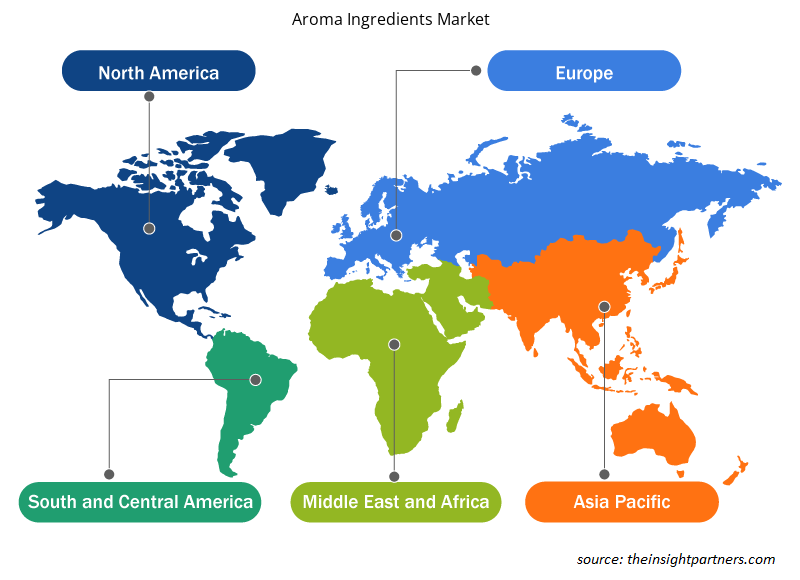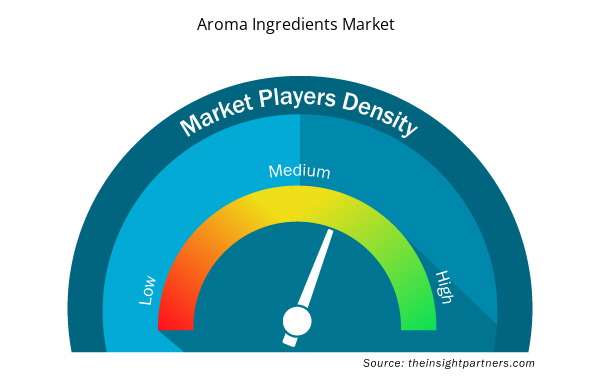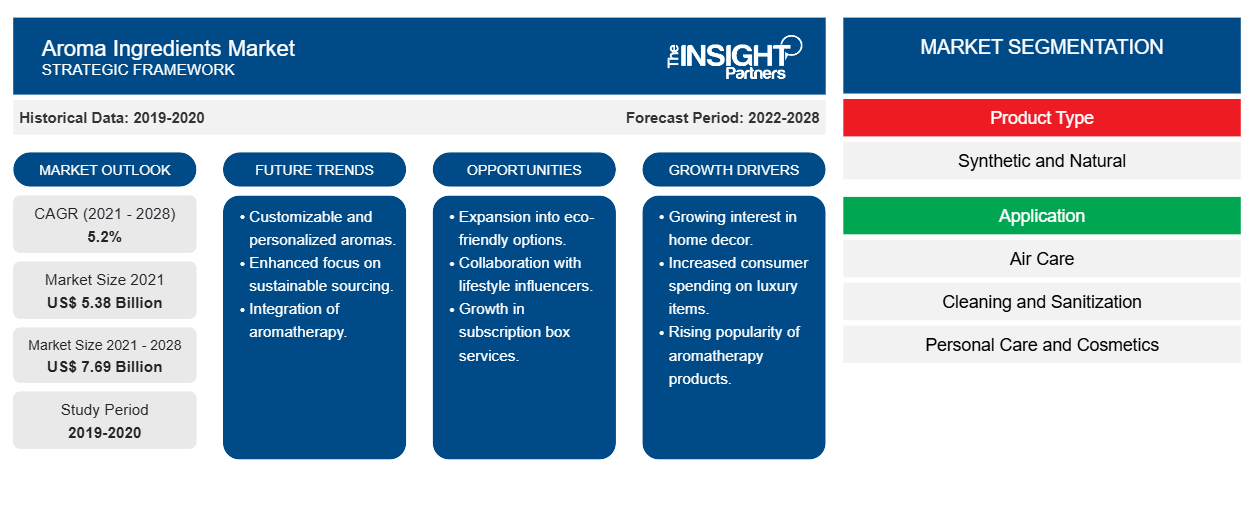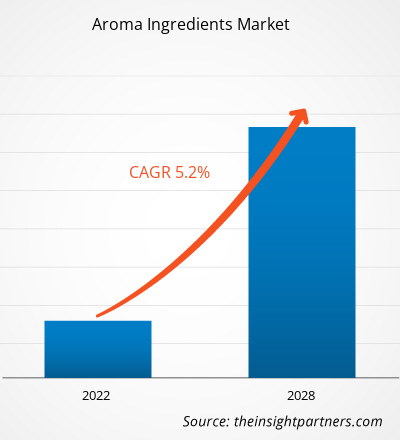2021 年香气成分市场价值为 53.769 亿美元,预计到 2028 年将达到 76.9262 亿美元;预计 2021 年至 2028 年的复合年增长率为 5.2%。CAGR of 5.2% from 2021 to 2028.
芳香成分基本上是复杂的化合物,添加到化妆品和个人护理产品以及家庭护理产品和其他产品中以赋予所需的香味。芳香成分可以是天然的,也可以是合成的。芳香成分包括精油、香精、分离物、油树脂、净油、芳香化学品和特殊芳香成分等。个人护理和化妆品行业的转型为芳香成分市场提供了许多新的增长机会,预计将在预测期内推动市场发展。oleoresins, absolutes, aroma chemicals, and special aroma ingredients among others. The transitioning personal care and cosmetics industry has provided numerous new growth opportunities for the
2020 年,亚太地区在全球芳香成分市场占据主导地位,预计在预测期内仍将保持主导地位。近年来,亚太地区个人对个人形象的意识不断增强,导致对化妆品的需求不断增加,从而推动了该地区化妆品市场的增长。亚洲消费者对体面的个人形象的渴望,促使他们更加注重个人卫生习惯。消费者对健康和卫生的日益关注,导致对个人护理、化妆品以及提供香味或香气的清洁和消毒产品的需求增加,进而导致对芳香成分的需求增加。此外,亚太地区包括印度和中国等国家,这些国家已成为众多使用芳香成分的终端市场制造中心。亚太发展中国家人口的增长以及可支配收入的增加,导致对个人护理和化妆品的需求增加。这种需求导致个人护理产品的国内产量增加,从而导致该地区对芳香成分的消费增加。
定制此报告以满足您的需求
您可以免费定制任何报告,包括本报告的部分内容、国家级分析、Excel 数据包,以及为初创企业和大学提供优惠和折扣
- 获取此报告的关键市场趋势。这个免费样品将包括数据分析,从市场趋势到估计和预测。
市场洞察
芳香成分的多种应用
芳香成分在空气净化、高级香水和香水、家用产品、食品和饮料以及药品等各种应用中的使用增加,导致对芳香成分的需求增加。高级香水包括香水、古龙水、身体喷雾和除臭剂等主要应用领域。芳香成分是高级香水配方中使用的基本元素之一。除此之外,芳香成分还用于家用产品,例如清洁剂、洗手液和洗碗液、洗衣护理和织物柔顺剂、湿巾和水性染料。因此,芳香成分应用的增加将推动芳香成分市场的增长。dishwashing liquids, laundry care and fabric softeners,
产品类型洞察
根据产品类型,芳香成分市场分为天然和合成。2020 年,天然部分是芳香成分市场中增长最快的部分。与合成化学品相关的健康问题的增加导致消费者对天然芳香成分的需求增加。然而,合成芳香成分相对更容易大规模生产,同时在所有批次中保持相同的质量。因此,合成成分的稳定质量因其广泛使用而获得了更大的市场份额,尤其是在快速消费品行业。
Takasago International Corporation、BASF SE、Firmenich SA、Givaudan SA、International Flavors & Fragrances Inc.、Robertet Group、Symrise、Mane、浙江新和成股份有限公司和 Phoenix Aromas & Essential Oils, LLC 是香精原料市场的主要参与者。领先的参与者采用多种策略,例如并购和产品发布,以扩大其地理覆盖范围和消费者基础。 International Corporation; BASF SE; Firmenich S.A.; Givaudan S.A.; International Flavors & Fragrances Inc.; Robertet Group; Symrise; Mane; Zhejiang NHU Co., Ltd.; and Phoenix Aromas & Essential Oils, LLC; are among the key players operating in the aroma ingredients market. The leading players adopt several strategies, such as mergers & acquisitions and product launches, to expand their geographic presence and consumer base.
芳香成分市场区域洞察
Insight Partners 的分析师已详尽解释了预测期内影响芳香成分市场的区域趋势和因素。本节还讨论了北美、欧洲、亚太地区、中东和非洲以及南美和中美洲的芳香成分市场细分和地理位置。

- 获取芳香成分市场的区域特定数据
芳香成分市场报告范围
| 报告属性 | 细节 |
|---|---|
| 2021 年市场规模 | 53.8亿美元 |
| 2028 年市场规模 | 76.9 亿美元 |
| 全球复合年增长率(2021 - 2028) | 5.2% |
| 史料 | 2019-2020 |
| 预测期 | 2022-2028 |
| 涵盖的领域 | 按产品类型
|
| 覆盖地区和国家 | 北美
|
| 市场领导者和主要公司简介 |
|
芳香成分市场参与者密度:了解其对业务动态的影响
芳香成分市场正在快速增长,这得益于终端用户需求的不断增长,而这些需求又源于消费者偏好的不断变化、技术进步以及对产品优势的认识不断提高等因素。随着需求的增加,企业正在扩大其产品范围,进行创新以满足消费者的需求,并利用新兴趋势,从而进一步推动市场增长。
市场参与者密度是指在特定市场或行业内运营的企业或公司的分布情况。它表明在给定市场空间中,相对于其规模或总市场价值,有多少竞争对手(市场参与者)存在。
在芳香成分市场运营的主要公司有:
- 高砂国际股份有限公司
- 巴斯夫
- 芬美意公司
- 奇华顿公司
- 国际香精香料公司
免责声明:上面列出的公司没有按照任何特定顺序排列。

- 获取芳香成分市场顶级关键参与者概览
报告亮点
- 香料原料行业的进步趋势,帮助参与者制定有效的长期战略
- 公司采用的业务增长战略来确保发达市场和发展中市场的增长
- 2019年至2028年全球香气原料市场定量分析
- 各行业对芳香成分的需求估计
- 波特分析说明了行业内买家和供应商预测市场增长的有效性
- 了解竞争激烈的市场形势和对芳香成分的需求的最新发展
- 市场趋势和前景以及推动和抑制香料成分市场增长的因素
- 了解全球芳香成分市场增长的商业利益所依赖的战略,从而帮助做出决策
- 不同市场节点的芳香原料市场规模
- 全球香料原料市场详细概述和细分以及行业动态
- 各地区芳香原料市场规模及增长机遇
“2028 年全球芳香成分市场分析”是一项针对化学品和材料行业的专业深入研究,特别关注全球芳香成分市场趋势分析。该报告旨在提供市场概述和详细的市场细分。芳香成分市场根据产品类型、应用和地理位置进行细分。根据产品类型,市场分为天然和合成。根据应用,市场分为空气护理、清洁和消毒、个人护理和化妆品、高级香水和香水等。根据地理位置,市场分为五个主要地区——北美、欧洲、亚太地区、中东和非洲以及南美和中美洲。
公司简介
- 高砂国际股份有限公司
- 巴斯夫
- 芬美意公司
- 奇华顿公司
- 国际香精香料公司
- 罗伯特集团
- 德之馨
- 鬃毛
- 浙江新和成股份有限公司
- 菲尼克斯香气与精油有限责任公司
- 历史分析(2 年)、基准年、预测(7 年)及复合年增长率
- PEST 和 SWOT 分析
- 市场规模价值/数量 - 全球、区域、国家
- 行业和竞争格局
- Excel 数据集


- Influenza Vaccines Market
- Webbing Market
- Oxy-fuel Combustion Technology Market
- Electronic Signature Software Market
- Nuclear Decommissioning Services Market
- Artificial Intelligence in Defense Market
- Ceiling Fans Market
- Saudi Arabia Drywall Panels Market
- Aircraft Landing Gear Market
- Architecture Software Market

Report Coverage
Revenue forecast, Company Analysis, Industry landscape, Growth factors, and Trends

Segment Covered
This text is related
to segments covered.

Regional Scope
North America, Europe, Asia Pacific, Middle East & Africa, South & Central America

Country Scope
This text is related
to country scope.
常见问题
Aroma ingredients are extensively used to create a wide range of fragrances. Increased healthcare awareness and disposable income have increased demand for consumer goods such as soaps, hand wash, sanitizers, detergents and toiletries. Although, the expansion of the personal care and household care industries significantly contributes to the growth of the aroma ingredient market. Manufacturers focus on increasing natural ingredients for the flavor and fragrance industry to ensure the sustainable sourcing of raw materials.
In 2020, the natural segment accounted for the fastest-growing segment. Natural aroma ingredients are extracted from natural sources, including wood, spices, flowers, and fruits. The rising awareness of the negative effects of synthetic ingredients on human health has increased the demand for natural and bio-based aroma ingredients.
Based on application, personal care and cosmetics are the fastest-growing segments. Aroma ingredients are extensively used in manufacturing personal care and cosmetics products. Continuous technological developments in the personal care and cosmetics sectors and innovations and research and development expenditures are expected to propel the growth of the aroma ingredient market.
In 2020, the synthetic segment accounted for the largest market share. Synthetic aroma ingredients can reproduce a natural and robust scent without compromising the fragrance to manufacture quality fragrance. It has strong demand in manufacturing soaps, shampoos, body lotions, hair conditioners, and other cosmetic and personal care products.
The major players operating in the global metakaolin market are Takasago International Corporation, BASF SE, Firmenich S.A., Givaudan S.A., International Flavors & Fragrances Inc., Robertet Group, Symrise, Mane, Zhejiang NHU Co., Ltd., and Phoenix Aromas & Essential Oils, LLC.
In 2020, Asia Pacific accounted for the largest share of the global aroma ingredient market. The aroma ingredient industry is anticipated to expand faster due to increasing awareness of personal care and hygiene.
Trends and growth analysis reports related to Chemicals and Materials : READ MORE..
The List of Companies - Aroma Ingredient Market
- Takasago International Corporation
- BASF SE
- Firmenich S.A.
- Givaudan S.A.
- International Flavors & Fragrances Inc.
- Robertet Group
- Symrise
- Mane
- Zhejiang NHU Co., Ltd.
- Phoenix Aromas & Essential Oils, LLC.
The Insight Partners performs research in 4 major stages: Data Collection & Secondary Research, Primary Research, Data Analysis and Data Triangulation & Final Review.
- Data Collection and Secondary Research:
As a market research and consulting firm operating from a decade, we have published and advised several client across the globe. First step for any study will start with an assessment of currently available data and insights from existing reports. Further, historical and current market information is collected from Investor Presentations, Annual Reports, SEC Filings, etc., and other information related to company’s performance and market positioning are gathered from Paid Databases (Factiva, Hoovers, and Reuters) and various other publications available in public domain.
Several associations trade associates, technical forums, institutes, societies and organization are accessed to gain technical as well as market related insights through their publications such as research papers, blogs and press releases related to the studies are referred to get cues about the market. Further, white papers, journals, magazines, and other news articles published in last 3 years are scrutinized and analyzed to understand the current market trends.
- Primary Research:
The primarily interview analysis comprise of data obtained from industry participants interview and answers to survey questions gathered by in-house primary team.
For primary research, interviews are conducted with industry experts/CEOs/Marketing Managers/VPs/Subject Matter Experts from both demand and supply side to get a 360-degree view of the market. The primary team conducts several interviews based on the complexity of the markets to understand the various market trends and dynamics which makes research more credible and precise.
A typical research interview fulfils the following functions:
- Provides first-hand information on the market size, market trends, growth trends, competitive landscape, and outlook
- Validates and strengthens in-house secondary research findings
- Develops the analysis team’s expertise and market understanding
Primary research involves email interactions and telephone interviews for each market, category, segment, and sub-segment across geographies. The participants who typically take part in such a process include, but are not limited to:
- Industry participants: VPs, business development managers, market intelligence managers and national sales managers
- Outside experts: Valuation experts, research analysts and key opinion leaders specializing in the electronics and semiconductor industry.
Below is the breakup of our primary respondents by company, designation, and region:

Once we receive the confirmation from primary research sources or primary respondents, we finalize the base year market estimation and forecast the data as per the macroeconomic and microeconomic factors assessed during data collection.
- Data Analysis:
Once data is validated through both secondary as well as primary respondents, we finalize the market estimations by hypothesis formulation and factor analysis at regional and country level.
- Macro-Economic Factor Analysis:
We analyse macroeconomic indicators such the gross domestic product (GDP), increase in the demand for goods and services across industries, technological advancement, regional economic growth, governmental policies, the influence of COVID-19, PEST analysis, and other aspects. This analysis aids in setting benchmarks for various nations/regions and approximating market splits. Additionally, the general trend of the aforementioned components aid in determining the market's development possibilities.
- Country Level Data:
Various factors that are especially aligned to the country are taken into account to determine the market size for a certain area and country, including the presence of vendors, such as headquarters and offices, the country's GDP, demand patterns, and industry growth. To comprehend the market dynamics for the nation, a number of growth variables, inhibitors, application areas, and current market trends are researched. The aforementioned elements aid in determining the country's overall market's growth potential.
- Company Profile:
The “Table of Contents” is formulated by listing and analyzing more than 25 - 30 companies operating in the market ecosystem across geographies. However, we profile only 10 companies as a standard practice in our syndicate reports. These 10 companies comprise leading, emerging, and regional players. Nonetheless, our analysis is not restricted to the 10 listed companies, we also analyze other companies present in the market to develop a holistic view and understand the prevailing trends. The “Company Profiles” section in the report covers key facts, business description, products & services, financial information, SWOT analysis, and key developments. The financial information presented is extracted from the annual reports and official documents of the publicly listed companies. Upon collecting the information for the sections of respective companies, we verify them via various primary sources and then compile the data in respective company profiles. The company level information helps us in deriving the base number as well as in forecasting the market size.
- Developing Base Number:
Aggregation of sales statistics (2020-2022) and macro-economic factor, and other secondary and primary research insights are utilized to arrive at base number and related market shares for 2022. The data gaps are identified in this step and relevant market data is analyzed, collected from paid primary interviews or databases. On finalizing the base year market size, forecasts are developed on the basis of macro-economic, industry and market growth factors and company level analysis.
- Data Triangulation and Final Review:
The market findings and base year market size calculations are validated from supply as well as demand side. Demand side validations are based on macro-economic factor analysis and benchmarks for respective regions and countries. In case of supply side validations, revenues of major companies are estimated (in case not available) based on industry benchmark, approximate number of employees, product portfolio, and primary interviews revenues are gathered. Further revenue from target product/service segment is assessed to avoid overshooting of market statistics. In case of heavy deviations between supply and demand side values, all thes steps are repeated to achieve synchronization.
We follow an iterative model, wherein we share our research findings with Subject Matter Experts (SME’s) and Key Opinion Leaders (KOLs) until consensus view of the market is not formulated – this model negates any drastic deviation in the opinions of experts. Only validated and universally acceptable research findings are quoted in our reports.
We have important check points that we use to validate our research findings – which we call – data triangulation, where we validate the information, we generate from secondary sources with primary interviews and then we re-validate with our internal data bases and Subject matter experts. This comprehensive model enables us to deliver high quality, reliable data in shortest possible time.


 获取此报告的免费样本
获取此报告的免费样本